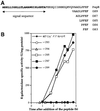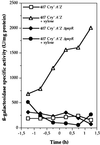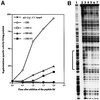A cell-cell signaling peptide activates the PlcR virulence regulon in bacteria of the Bacillus cereus group
- PMID: 12198157
- PMCID: PMC126190
- DOI: 10.1093/emboj/cdf450
A cell-cell signaling peptide activates the PlcR virulence regulon in bacteria of the Bacillus cereus group
Abstract
PlcR is a pleiotropic regulator that activates the expression of genes encoding various virulence factors, such as phospholipases C, proteases and hemolysins, in Bacillus thuringiensis and Bacillus cereus. Here we show that the activation mechanism is under the control of a small peptide: PapR. The papR gene belongs to the PlcR regulon and is located 70 bp downstream from plcR. It encodes a 48-amino-acid peptide. Disruption of the papR gene abolished expression of the PlcR regulon, resulting in a large decrease in hemolysis and virulence in insect larvae. We demonstrated that the PapR polypeptide was secreted, then reimported via the oligopeptide permease Opp. Once inside the cell, a processed form of PapR, presumably a pentapeptide, activated the PlcR regulon by allowing PlcR to bind to its DNA target. This activating mechanism was found to be strain specific, with this specificity determined by the first residue of the penta peptide.
Figures








References
-
- Agaisse H. and Lereclus,D. (1994) Structural and functional analysis of the promoter region involved in full expression of the cryIIIA toxin gene of Bacillus thuringiensis. Mol. Microbiol., 13, 97–107. - PubMed
-
- Agaisse H., Gominet,M., Økstad,O.A., Kolstø,A.B. and Lereclus,D. (1999) PlcR is a pleiotropic regulator of extracellular virulence factor gene expression in Bacillus thuringiensis. Mol. Microbiol., 32, 1043–1053. - PubMed
-
- Agata N., Ohta,M., Mori,M. and Isobe,M. (1995) A novel dodecadepsipeptide, cereulide, is an emetic toxin of Bacillus cereus. FEMS Microbiol. Lett., 129, 17–20. - PubMed
-
- Amrein K.E., Takacs,B., Stieger,M., Molnos,J., Flint,N.A. and Burn,P. (1995) Purification and characterization of recombinant human p50csk protein-tyrosine kinase from an Escherichia coli expression system overproducing the bacterial chaperones GroES and GroEL. Proc. Natl Acad. Sci. USA, 92, 1048–1052. - PMC - PubMed
-
- Arantes O. and Lereclus,D. (1991) Construction of cloning vectors for Bacillus thuringiensis. Gene, 108, 115–119. - PubMed
Publication types
MeSH terms
Substances
Associated data
- Actions
- Actions
- Actions
- Actions
- Actions
- Actions
- Actions
- Actions
- Actions
- Actions
- Actions
- Actions
- Actions
- Actions
- Actions
- Actions
LinkOut - more resources
Full Text Sources
Other Literature Sources

